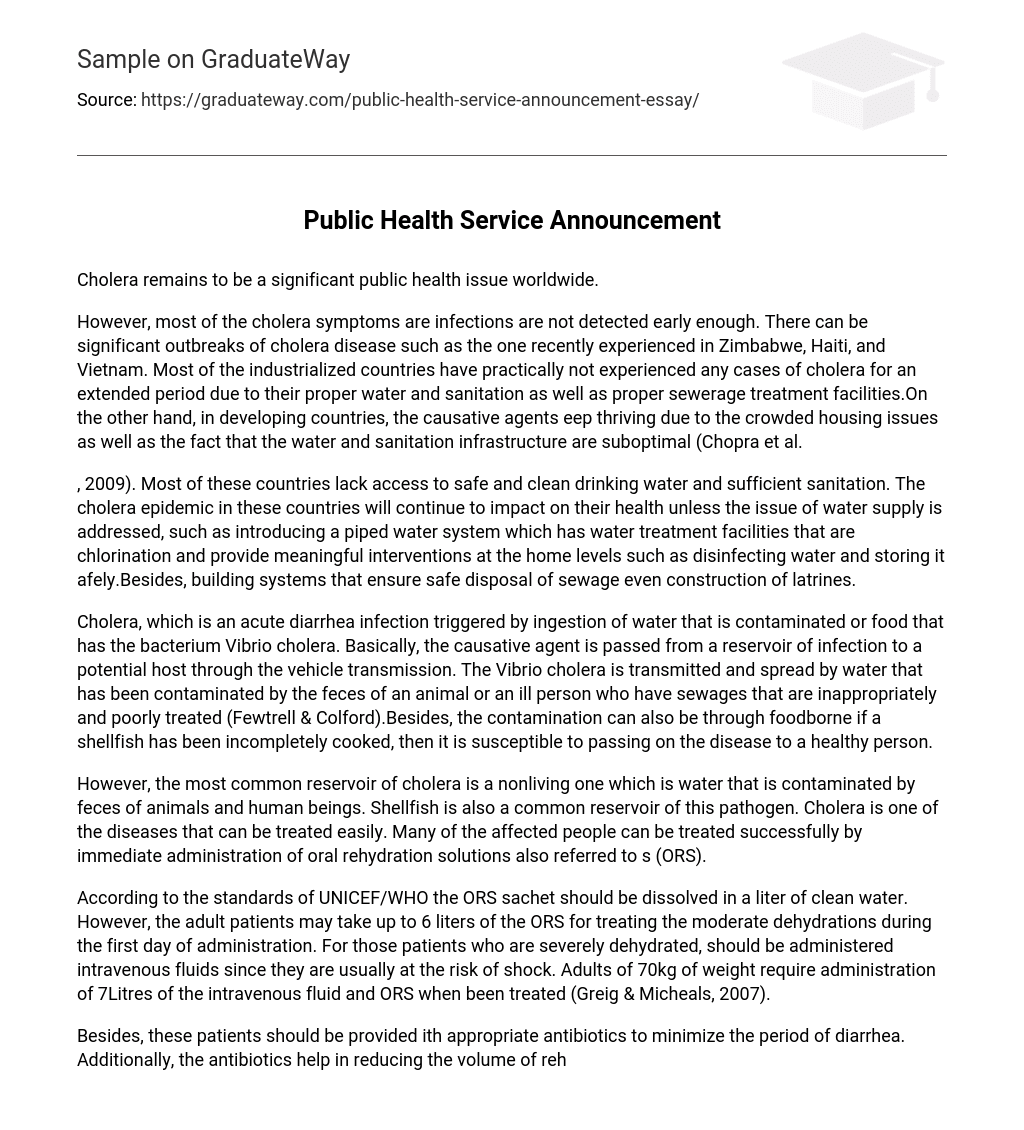Cholera remains to be a significant public health issue worldwide.
However, most of the cholera symptoms are infections are not detected early enough. There can be significant outbreaks of cholera disease such as the one recently experienced in Zimbabwe, Haiti, and Vietnam. Most of the industrialized countries have practically not experienced any cases of cholera for an extended period due to their proper water and sanitation as well as proper sewerage treatment facilities.On the other hand, in developing countries, the causative agents eep thriving due to the crowded housing issues as well as the fact that the water and sanitation infrastructure are suboptimal (Chopra et al.
, 2009). Most of these countries lack access to safe and clean drinking water and sufficient sanitation. The cholera epidemic in these countries will continue to impact on their health unless the issue of water supply is addressed, such as introducing a piped water system which has water treatment facilities that are chlorination and provide meaningful interventions at the home levels such as disinfecting water and storing it afely.Besides, building systems that ensure safe disposal of sewage even construction of latrines.
Cholera, which is an acute diarrhea infection triggered by ingestion of water that is contaminated or food that has the bacterium Vibrio cholera. Basically, the causative agent is passed from a reservoir of infection to a potential host through the vehicle transmission. The Vibrio cholera is transmitted and spread by water that has been contaminated by the feces of an animal or an ill person who have sewages that are inappropriately and poorly treated (Fewtrell & Colford).Besides, the contamination can also be through foodborne if a shellfish has been incompletely cooked, then it is susceptible to passing on the disease to a healthy person.
However, the most common reservoir of cholera is a nonliving one which is water that is contaminated by feces of animals and human beings. Shellfish is also a common reservoir of this pathogen. Cholera is one of the diseases that can be treated easily. Many of the affected people can be treated successfully by immediate administration of oral rehydration solutions also referred to s (ORS).
According to the standards of UNICEF/WHO the ORS sachet should be dissolved in a liter of clean water. However, the adult patients may take up to 6 liters of the ORS for treating the moderate dehydrations during the first day of administration. For those patients who are severely dehydrated, should be administered intravenous fluids since they are usually at the risk of shock. Adults of 70kg of weight require administration of 7Litres of the intravenous fluid and ORS when been treated (Greig & Micheals, 2007).
Besides, these patients should be provided ith appropriate antibiotics to minimize the period of diarrhea. Additionally, the antibiotics help in reducing the volume of rehydration fluid required and also the amount and time of V. cholerae excretion from their stool are shortened. Water Supply and Cholera As earlier stated, the agents of cholera are many, but the major one is a nonliving reservoir referred to as water.
According to studies, there is a close relationship between the lack of tap water and high level of the incidences of cholera.Although the piped water can also cause he disease if not properly treated, the availability if tap water supply significantly reduces the rates of prospected cholera. Efforts of Public Health to Minimize Cholera Illness The area of public health looks at broader ways to solve illness and health. Those ways comprise of the entire populations and implementation of health practices (Tappero, 2011).
After the cholera epidemic that occurred in Haiti in October 2010, many countries responded to help, and this triggered a need for the public health field to put efforts necessary to minimize the pread of cholera.Although some of the interventions required minimizing the spread of this disease in developing countries, need some long-term investments and persistent maintained which may be difficult to fund but are of great importance (Greig & Micheals, 2007). The public health is committed to educating the general public on the dangers of the disease and some of the ways they can take care of themselves to minimize the widespread do the agents of cholera. Some of the ways include: washing hands after visiting the washrooms and ensuring that water is roperly treated and finally always to cook food well.
The challenge of water supply in developing countries is the major contributor to the development of cholera as a disease. However, the problem can partly be solved by holding health education campaigns which facilitate the proper use of hygiene practices such as the proper food preparation and hand washing with soap. The long-term solution, however, lays on the construction of safe water treatment reservoirs so that the drinking water should always be safe to drink.





